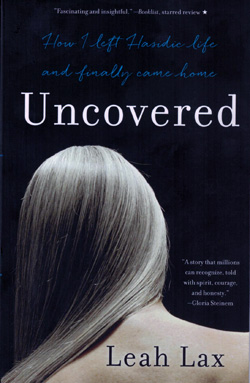Uncovered by Leah Lax; She Writes Press; © 2015; ISBN 978-1631529955; $16.95
By Donald H. Harrison

 SAN DIEGO – This touchingly written, respectful yet controversial, woman’s odyssey from unhappy, repressed childhood to Hasidism and thence, in middle age, to freedom and the personal security found in lesbianism, is bound to be earnestly debated by readers. The memoir is richly textured, and at the same time, filled with the gaps of “what ifs.”
SAN DIEGO – This touchingly written, respectful yet controversial, woman’s odyssey from unhappy, repressed childhood to Hasidism and thence, in middle age, to freedom and the personal security found in lesbianism, is bound to be earnestly debated by readers. The memoir is richly textured, and at the same time, filled with the gaps of “what ifs.”
I take it as a maxim that for one to be happy, one must run “to” something, rather than “from” something. Clearly, Leah (ne Lisa) Lax was running from her dysfunctional family when she started attending Shabbats at her college Chabad house. Here, instead of disorder, she found order; instead of chaos, she found rules. She mistook the structure of Hasidic life for personal safety, although she wasn’t quite certain what she needed to be keep safe from. The memories of her father sexually abusing her as a child had long ago been repressed, but her resentment against her mother, who did not or could not protect her, remained.
Before long, she made a commitment to the Hasidic lifestyle, and was married by arrangement to Levi, an underdeveloped and remote character in this memoir, who built his life around the rituals of Orthodox Judaism and abandoned Leah to the functions of making meals and making babies. Although she tried to subsume her identity in the home rituals and everyday tasks of raising a large family, without the help of her husband, Leah became increasingly aware of how unhappy she was. There were many things about devout religious observance that continued to appeal to Leah – the ritual of mikvah as a metaphor for spiritual rebirth, among them – but her home life became increasingly intolerable.
Although they made children, Leah and Levi did not make love. Their calendar-regulated sexual unions were pro forma, bringing to Leah no satisfaction. Before her marriage, and after, she had erotic dreams, not about other men, but of making love to women.
Throughout her life, Leah played the cello – the shape of which has often been compared to the body of a woman – and desperately needing creative outlet, Leah returned to university to study music, to read secular books, and to dissipate some of the pressure of living in what, for her, but not necessarily for others, was a closed and unsatisfying world.
Initially she continued to dress as a Hasidic woman, with covered limbs and hair, and when asked, she gave Hasidic explanations for such questions as why in Orthodox Judaism women are not allowed to participate in mixed Torah services, and why they have to sit behind a mehitzah. But eventually Leah “uncovered” herself, shedding her Hasidic clothes for more secular styles, an act which led to her more fully articulating her own doubts and frustrations, as well as to friendships, discussions, touches, and eventually to a lesbian love affair.
However, when Levi contracted cancer, Leah rallied to his aid, once again trying to subordinate her identity to the needs of her family. While Levi was appreciative, the gap between them was too wide for this to be anything but a temporary palliative for their marriage.
For a while Leah led two lives—that of the rebellious, but still observant Hasidic wife at home, and that of a woman open to sensual experiences and new ways of thought at her lover’s home. With her children grown or almost grown, she and Levi quite logically divorced and Leah became openly lesbian, while continuing to be a practicing Jew, adjusting rituals and prayers to her new reality.
Here are some of the controversies raised within this fascinating volume: Did Leah run “to” lesbianism or “from” Hasidism? While she paints an idyllic picture of her life today, it should be noted, that she and her first lover separated, and now she is married to another woman. Are they really “bashert” or has Leah once again subsumed herself in a new identity? As she did when she was Hasidic, does she now say what is expected of her as a lesbian? Has she changed life styles as she might change clothes? Is she still looking for her real self?
As we all know, there is an ongoing debate about whether homosexuality is a learned behavior or whether it is part of our genetic makeup. This book does not provide answers. We are left with ambivalent feelings on the question. Did Leah’s father and later her husband drive her to a woman’s arms? Or was within the feminine embrace where she belonged from the very start?
I recommend that you read this carefully constructed book. See if you can decide.
*
Harrison is editor of San Diego Jewish World. You may comment to him at donald.harrison@sdjewishworld.com
Leah Lax, the author, writes: I submit that a book review needs to be a review of the book, but you took license to go beyond and review my sexual orientation and current life as well–not in your purview to scrutinize. Your “Has she changed life styles as she might change clothes?” referring to my sexual orientation as a “life style” (is yours?) and something easily discarded and exchanged at whim, trivializes and dismisses a whole class of people, which in my book is a common definition of bigotry. There is such an obvious fundamental difference between changing something basic to your being (not possible) and living a pretense that it convinces me you did not read my book, or you read it with such preconceived notions you couldn’t hear the book at all.